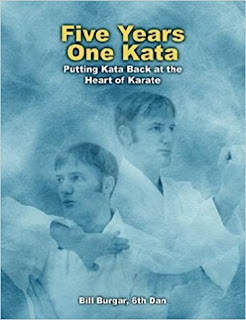"Five Years One Kata" by William Burgar. A Review
Five Years One Kata: Putting Kata Back at the Heart of Karate
William Burgar
Martial Arts Publishing Limited
http://martialartspublishing.co.uk/
ISBN: 978-0954446604; March 2003; $29.95
4 Stars out of 5
Many martial art schools use katas,
Poomsae, or forms, with minimal instruction
as to what each technique is for. Some traditions seem to do better than others
in this regard. One of my most memorable moments in kata came when an
instructor spent a whole class session walking us through the five opening steps
of an advanced form. During this time he explained each movement’s defensive
and assaultive uses. And then he worked us through applying the techniques on
our fellow karateka. This left a lasting impression on my mind as to the value of,
and intent behind, kata learning. Several years back William Burgar, sixth dan
in Shotokan karate, complied “Five Years One Kata: Putting Kata Back at the
Heart of Karate”. This 336 page manual chronicles his five year experiment of
focusing on one single kata (Gojushiho), and what he acquired in the process.
“Five Years One Kata” walks the
reader through the history of kata, and Burgar’s theories about their initial
origin, purpose and present value. According to the author, the kata “was
originally a civilian art of defense as opposed to a martial (battlefield)
method” (30). Further, the kata was not crafted to teach techniques. Rather it was
a mnemonic device, a memory aid, for helping a person to recall the tactics
they had already learned. The goal is to move the student from the learning and
practicing stages, to the drilling phase when “the technique is second nature”
(37). By taking this approach, the present value of kata lies in preparing the
karateka to respond and react to habitual acts of violence.
Burgar then spends the bulk of the
book unpacking Gojushiho kata, and its application. This center piece of “Five
Years One Kata” is packed full of black and white pictures showing each
technique and how it might be used in normal violent settings. Accompanying the
pictures are printed explanations and directions describing what one see in the
photographs. The book would be seriously enhanced by higher quality photographs.
The manuscript wraps up with simple
plans for building your own kata and setting up a training regimen around your form.
The final chapter pulls the book together where the author explains his own
idea on this subject. Since “the primary goal of the karateka is to learn,
practice and perfect a system of civilian self-defense to combat the habitual
acts of violence…that one may face in common scenarios” (317), then a person
must develop their own unique memory device. If the reader didn’t grasp the
point of the book earlier, it all becomes clear in the last part: make your own
kata out of the techniques you’ve learned over the years, and slowly add to it
as you gain new defenses and skills.
“Five Years One Kata” is an encouraging volume. It was helpful in explaining the significance using poomsae, delving deeply into it, and working at its application in normal self-protection situations. Though the book is over fourteen years old, nevertheless it is still applicable. Even if a karateka doesn’t desire to craft their own kata, it will give them inspiration for making the forms they know more personal and practical. I recommend the book.
“Five Years One Kata” is an encouraging volume. It was helpful in explaining the significance using poomsae, delving deeply into it, and working at its application in normal self-protection situations. Though the book is over fourteen years old, nevertheless it is still applicable. Even if a karateka doesn’t desire to craft their own kata, it will give them inspiration for making the forms they know more personal and practical. I recommend the book.




Comments